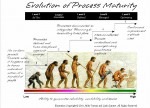
Institutionalization is an important concept in process improvement. It implies that the process is ingrained in the way the work is performed and there is company-wide commitment and consistency to performing the process. »
|
||||

A maturity model is a structured collection so called maturity levels that describe characteristics of effective processes » 
Process Maturity Levels are a layered framework for leveling Process Maturity. They provide a progression needed for continuous and process improvement. For an organisation it is not a matter of adopting the ability to assess the impact of new practices, technologies, or tools. More than it is a matter of determining how innovative efforts influence existing organisational practices. By this maturity levels really empowers projects, teams, and organizations by giving them the foundation to support reasoned choice. » 
(Deutsch) ISO/IEC 15504 — auch bekannt unter dem Namen SPiCE (Software Process Improvement and Capability dEtermination) ist eine internationale Norm des ISO-Institutes zur Bewertung von Unternehmensprozessen für Software- und Elektronikentwicklung (Embedded Systems). ISO/IEC 15504 ist in den neunziger Jahren aus einem Projekt des Joint Technical Subcommittee zwischen der ISO und der IEC entstanden. Gegenstand von ISO/IEC 15504 ist die Bewertung von Softwareentwicklungsprozessen (sogn. Prozessassessments) und die Anforderungen an solche Bewertungen, sowie die Nutzung der Norm. ISO/IEC 15504 definiert in einem Referenzmodell zentrale Prozesse,deren Relevanz bei jeder Software-/Embedded System-Entwicklung betrachtet werden sollten, und in einem Assessmentmodell, wie die Ausprägung dieser Prozesse in einer Organisation zu bewerten sind. » |
||||
|
© Copyright 2010-2024 Plays-in-Business. All Rights Reserved.  Powered by WordPress & Atahualpa |
||||